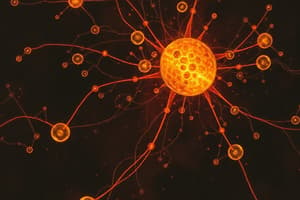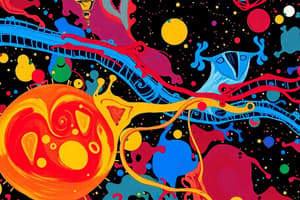Podcast
Questions and Answers
What is the primary factor required for the activation of aPKC?
What is the primary factor required for the activation of aPKC?
- Phorbol esters
- Phosphatidyl serine (PS) (correct)
- Diacylglycerol (DAG)
- Calcium ions
Which of the following components binds to the C1 domain of PKC?
Which of the following components binds to the C1 domain of PKC?
- Threonine
- Zinc ions (correct)
- Phosphatidyl serine
- Calcium ions
What role does the C2 domain of PKC play after activation?
What role does the C2 domain of PKC play after activation?
- It binds zinc ions to activate the kinase.
- It acts as a pseudosubstrate for autophosphorylation.
- It directly phosphorylates phosphatidyl serine.
- It facilitates translocation to the cell membrane. (correct)
Which phosphorylation is also known as autophosphorylation in the activation process of PKC?
Which phosphorylation is also known as autophosphorylation in the activation process of PKC?
What is the correct sequence of activation leading to an active C2 domain in PKC?
What is the correct sequence of activation leading to an active C2 domain in PKC?
What is the role of the PH domain in PLCβ?
What is the role of the PH domain in PLCβ?
Which of the following statements is true about the PLC isoforms?
Which of the following statements is true about the PLC isoforms?
Which subunit does Gq/11 signaling activate in relation to PLCβ?
Which subunit does Gq/11 signaling activate in relation to PLCβ?
What does the C2 domain of PLCβ do?
What does the C2 domain of PLCβ do?
Which of the following G proteins can activate PLCβ?
Which of the following G proteins can activate PLCβ?
What structural feature enhances the catalytic activity of PLCβ?
What structural feature enhances the catalytic activity of PLCβ?
Which substance does PLCβ utilize as a substrate?
Which substance does PLCβ utilize as a substrate?
Which PLC isoform is most commonly recognized as prototype?
Which PLC isoform is most commonly recognized as prototype?
What role do anchoring proteins play for PKC?
What role do anchoring proteins play for PKC?
Which of the following is NOT a mechanism of PKC activation?
Which of the following is NOT a mechanism of PKC activation?
What happens to PKC when there is prolonged stimulation with phorbol esters?
What happens to PKC when there is prolonged stimulation with phorbol esters?
Which proteins are involved in directing atypical C-kinases like PKC?
Which proteins are involved in directing atypical C-kinases like PKC?
The pseudosubstrate domain of PKC must be released to allow what process?
The pseudosubstrate domain of PKC must be released to allow what process?
What is the primary consequence of DAG being phosphorylated by DAG kinases?
What is the primary consequence of DAG being phosphorylated by DAG kinases?
What role do RACKs play in relation to PKC?
What role do RACKs play in relation to PKC?
Calcium signaling in the context of PKC activation primarily affects which aspect?
Calcium signaling in the context of PKC activation primarily affects which aspect?
What initiates catalysis in PLCβ?
What initiates catalysis in PLCβ?
Which domains are present in the specific isoform of PLCβ mentioned?
Which domains are present in the specific isoform of PLCβ mentioned?
Which substance is known to compete with DAG for its binding site?
Which substance is known to compete with DAG for its binding site?
How many isozymes are present in the human PKC family?
How many isozymes are present in the human PKC family?
Which regulatory domain of PKC binds calcium and a phosphoinositide?
Which regulatory domain of PKC binds calcium and a phosphoinositide?
Which PKC subfamily is characterized by conventional isoforms?
Which PKC subfamily is characterized by conventional isoforms?
What must happen to the C-lobe in PKC for catalysis to be enabled?
What must happen to the C-lobe in PKC for catalysis to be enabled?
What type of kinase is PKC described as?
What type of kinase is PKC described as?
Flashcards
PKC
PKC
A family of lipid-regulated Ser/Thr kinases involved in cell signaling.
C1 Domain
C1 Domain
The domain in PKC that binds to DAG (diacylglycerol), phosphatidyl serine, and phorbol esters like PMA (phorbol myristate acetate).
aPKC
aPKC
A type of PKC that lacks the C2 domain, so it does not bind to calcium. It only needs phosphatidyl serine (PS) for activation.
PKC Activation Steps
PKC Activation Steps
Signup and view all the flashcards
What is the role of the C2 domain in PKC activation?
What is the role of the C2 domain in PKC activation?
Signup and view all the flashcards
What activates PKC?
What activates PKC?
Signup and view all the flashcards
What inactivates PKC?
What inactivates PKC?
Signup and view all the flashcards
How does PKC become active?
How does PKC become active?
Signup and view all the flashcards
PKC's Membrane Association
PKC's Membrane Association
Signup and view all the flashcards
Anchoring Proteins and PKC
Anchoring Proteins and PKC
Signup and view all the flashcards
RICKS/AKAPs
RICKS/AKAPs
Signup and view all the flashcards
STICKs
STICKs
Signup and view all the flashcards
PLC-IP3-DAG Pathway
PLC-IP3-DAG Pathway
Signup and view all the flashcards
Phospholipase C (PLC)
Phospholipase C (PLC)
Signup and view all the flashcards
What are the products of PLC activity?
What are the products of PLC activity?
Signup and view all the flashcards
What are the roles of IP3 and DAG?
What are the roles of IP3 and DAG?
Signup and view all the flashcards
What are the four families of PLC isoforms?
What are the four families of PLC isoforms?
Signup and view all the flashcards
What is the simplest PLC isoform?
What is the simplest PLC isoform?
Signup and view all the flashcards
What are the domains of PLCδ?
What are the domains of PLCδ?
Signup and view all the flashcards
How does PLCβ bind to the membrane?
How does PLCβ bind to the membrane?
Signup and view all the flashcards
PLCβ Activation
PLCβ Activation
Signup and view all the flashcards
PLCβ and RTKs
PLCβ and RTKs
Signup and view all the flashcards
PLCβ Second Messengers
PLCβ Second Messengers
Signup and view all the flashcards
PKC Activation
PKC Activation
Signup and view all the flashcards
What are Phorbol Esters?
What are Phorbol Esters?
Signup and view all the flashcards
PKC's Domains
PKC's Domains
Signup and view all the flashcards
PKC Subfamilies
PKC Subfamilies
Signup and view all the flashcards
PKC Activation Mechanism
PKC Activation Mechanism
Signup and view all the flashcards
Study Notes
Lecture 5: Effector Systems and Second Messengers Downstream of GPCRs (Part 2)
- PLC-(IP3 & DAG)-PKC pathway is a key downstream pathway of GPCRs
- Main pathways downstream of GPCRs include AC-cAMP-PKA and PLC-(IP3 & DAG)-PKC pathways
- Phospholipase C (PLC) cleaves phosphatidylinositol 4,5-bisphosphate (PIP2) to form diacylglycerol (DAG) and inositol 1,4,5-trisphosphate (IP3)
- DAG activates protein kinase C (PKC)
- IP3 triggers release of calcium from the endoplasmic reticulum
- Calcium and DAG are activators of PKC
- Mammalian PLC has four families based on sequence similarities: PLCβ (most significant), PLCY, PLCδ (prototype), and PLCE
- PLCδ is considered as a prototype and the simplest PLC isoform
- PLCδ is made up of a PH domain, EF-hand motif, C2 domain, and X-Y catalytic domains
PLC Family
- PLCβ can be activated with Gq/11, Gi and Go
- Gq/11 signaling is activated by binding to α-subunit (Gαq/11) (e.g., bradykinin receptor)
- Gi and Go signaling is activated by binding to βγ-subunits (e.g., acetylcholine M2 receptor)
- GPCRs coupled to Gαq triggers a cascade to PLC, IP3, and DAG, which results in PKC activation ultimately impacting smooth muscle contraction and vesicle release
PKC
- PKC is cyclic nucleotide-independent protein kinase
- First isolated from bovine cerebellum in the 1970s
- PKC has 3 main subgroups: Conventional, Novel, Atypical
- Conventional CPKC consists of 4 isoforms a, β1, β2, and γ
- Novel nPKC contains 3 isoforms δ, ε, η and θ
- Atypical aPKC includes 4 isoforms ι, ζ, μ, and λ
PKC Activation
- PKC is activated by Diacylglycerol (DAG), Calcium (Ca2+), and phorbol esters (e.g., PMA)
- Phosphorylation and autophosphorylation steps are part of the process of activation
- PKC downregulation occurs through prolonged stimulation with phorbol esters leading to dephosphorylation and degradation of PKC; also with DAG kinases converting DAG to phosphatidic acid depleting DAG stores
Anchoring Proteins
- Some PKCs cannot translocate to the plasma membrane by themselves, needing help of anchoring proteins
- These proteins include PDZ-containing proteins or non-PDZ-containing proteins
- These proteins help with the precise localization of PKCs
PKC Activation Sequence
- PKC starts as an inactive precursor often associated to the cytoskeleton, readily accessible to ATP
- Phosphorylation stages occur at Thr500, Thr641 and Ser660 leading to active C2 domain
- Ca2+ binding helps PKC translocate to the membrane via phosphatidylserine (PS)
- Other kinases participate in the release of pseudosubstrate domain for full activation
PKC Different States
- Catylically incompetent
- Catylically competent but inactive
- Active
Latest Theory of PKC Activation
- DAG and Ca2+ binding to PKC improves membrane association and increases its recognition by PDK1, enhancing subsequent activation of catalytic domain
Additional Information
- PKC activation is modulated by anchoring proteins
- Example of interaction with PDZ-based scaffold is the interaction of eye-PKC with InaD in the rhodopsin signaling pathway
- Different receptor families are involved in PKC anchoring including RICK/AKAPS, STICKS and RACKS, and PICKS.
- The final step leading to activation involves release of the pseudosubstrate domain from the N-terminal of PKC.
Studying That Suits You
Use AI to generate personalized quizzes and flashcards to suit your learning preferences.
Related Documents
Description
Dive into the intricacies of effector systems and second messengers downstream of GPCRs in this quiz. Explore the PLC-(IP3 & DAG)-PKC pathway and its role in cellular signaling. Test your knowledge on phospholipase C families and their activation mechanisms.




